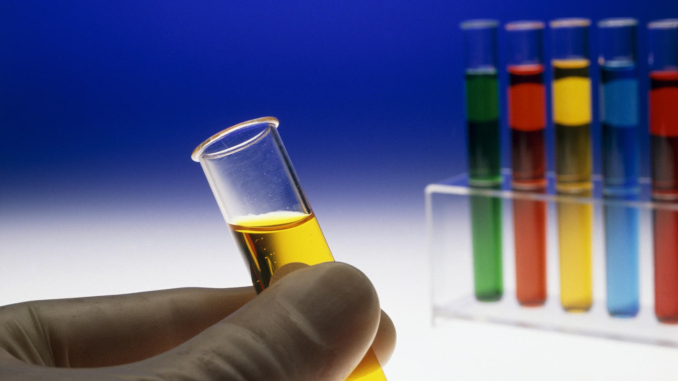
By Nick Griffin
Many Americans believe that the United States has the best food standards in the world. In fact, the U.S. food system is awash with ingredients deemed so unsafe that other countries ban them.
Click the Link Below to Listen to the Audio of this Article
In the last issue, we examined some of the worst chemicals Americans are ingesting and which of these chemicals are banned in Europe. These most notably include the bread additives potassium bromate and azodicarbonamide, and the artificial food coloring Red 3.
Unfortunately, they are only a few on the list of the chemicals steadily poisoning millions of Americans, while banned in countries where corporate lobbies have less clout.
Colored Dyes
Red 3 isn’t the only synthetic food dye associated with neuro-behavioral problems in children. Blue 1, Blue 2, Green 3, Red 40, Yellow 5, and Yellow 6 can be found in popular products including Skittles, Doritos, Pop Tarts, Gatorade, Lucky Charms, Tostitos Queso dip, Pillsbury Crescent Rolls, and Little Debbie’s snacks.
Brominated Vegetable Oil
Then there is brominated vegetable oil. Used as an emulsifier in sports drinks and citrus-flavored drinks such as Sun Drop. It is banned in the European Union (EU) because bromine can build up in the body and lead to memory loss as well as skin and nerve problems, and organ damage.
Potassium Iodate
In addition to the toxic bread additives already examined, potassium iodate is used as a dough strengthener. The World Health Organization (WHO) has warned against the use of this potential carcinogen in flour since 1965. The WHO is a clear threat to health sovereignty, and Donald Trump’s decision to withdraw from it is commendable, but this doesn’t mean it is sensible to ignore its non-political warnings about cancer.
Butylated WHAT?
This is not the only cancer threat. Butylated hydroxyanisole (BHA) and butylated hydroxytoluene (BHT) are added to food to prevent spoilage.
In 2011, The U.S. Department of Health and Human Services stated that BHA “is reasonably anticipated to be a human carcinogen.” Yet, despite that warning, and their being banned in Europe, both are still legal in the United States. Watch out for Frosted Flakes, Stove Top Stuffing, Honey Bunches of Oats, Wheat Thins, Farmer John Breakfast Sausage Links, and Rice Krispies for BHA.
Titanium Dioxide
Titanium dioxide is used for coloring in candies such as skittles and starburst as well as food like soups and spreads. It is genotoxic, which means it can cause DNA damage, leading to cancer and other health problems. It is already four years since the European Food and Safety Administration stated that it no longer considered this additive safe when used as a food additive.
But although it now faces a ban in California, American children everywhere else will go on gobbling titanium dioxide.
Propylparaben
Another ingredient facing a California ban is propylparaben. This widely used preservative has been linked to breast cancer and banned in European food for 20 years.
OLESTRA
Last on the known list of dangerous food additives still allowed in the United States is olestra, which is used in diet versions of chips and fries. It has been linked to gastrointestinal disease and is banned in Canada as well as the EU.
SYNTHETIC HORMONES
Sadly, the danger and government neglect of duty doesn’t end there. Potential poisons getting into the food chain through agricultural use are also a very serious issue.
Recombinant bovine growth hormone and recombinant bovine somatotropin are given to cows to increase milk production. Milk in the United States, unless marked otherwise, contains one or other of these artificial hormones, despite having been banned in the EU due to its link to breast, prostate, and colon cancers.
The same is true of synthetic hormones used to promote growth in meat animals. Most notable among these is ractopamine. Used to promote lean muscle growth in pigs and cattle, it has been linked to cardiovascular damage and other human health problems. Banned in 122 countries. It is—somehow— still legal in the USA.
ROXARSONE
Growth in chickens is encouraged with arsenic-based roxarsone. This drug also kills parasites and improves the coloring of the meat. Banned in the EU, it is still putting Americans at risk of anemia, skin lesions and kidney damage.
WHY?
The logical question is: Why is there is so much difference when it comes to food additives on either side of the Atlantic? Apart from the power of the industrial food lobby in the U.S., there are three key reasons:
First, the United States doesn’t have a system to re-evaluate products when research or medical discoveries reveal a problem. While the EU periodically re-evaluates old determinations, America has no such process.
Second, the EU considers safety on the “possibility” of sickness. In America, the Food and Drug Administration (FDA) determines safety on the “probability” of sickness. This leads to vastly different policies, allowing U.S. corporations to skirt safety concerns.
Third is the GRAS loophole. Created in 1958, GRAS is an acronym for Generally Recognized as Safe. It allows food corporations to “self-certify” the safety of additives and chemicals they put into your food.
More than 10,000 chemicals are allowed for use in food sold in the United States. Nearly 99% of those introduced since 2000 were approved by the food and chemical industry itself, not the FDA.




